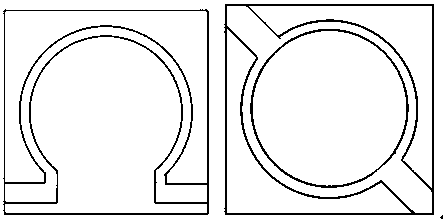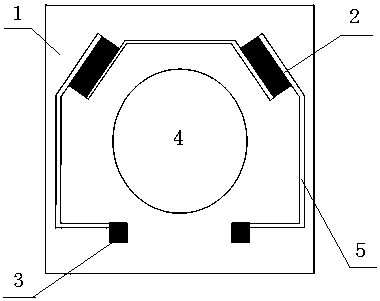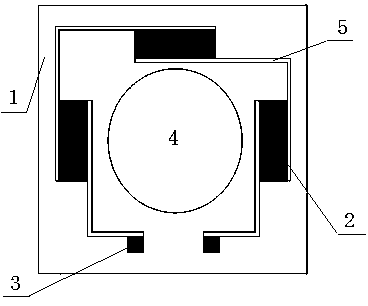A Micro Thin Film Resistance Heater
A thin film resistor and heater technology, applied in ohmic resistance heating, electric heating devices, electrical components, etc., can solve the problems of limited material selection, small size, difficult block packaging, etc., to reduce thermal time constant and improve thermal controllability. the effect of improving the heating efficiency
- Summary
- Abstract
- Description
- Claims
- Application Information
AI Technical Summary
Problems solved by technology
Method used
Image
Examples
Embodiment 1
[0037] Embodiment 1: as figure 2 As shown, the number of area units of the resistive sheet 2 is 2, and the two resistive sheets 2 are arranged on one side of the substrate 1, symmetrically along the forbidden area, and the pad 3 is arranged on the other side of the substrate 1, and the two resistive sheets 2 Connect to pad 3 in series through a wire.
Embodiment 2
[0038] Embodiment 2: as image 3 As shown, the number of area units of the resistive sheet 2 is 3, and each resistive sheet 2 is arranged in the middle of the three sides of the substrate 1, and the pad 3 is arranged in the middle of the fourth side of the substrate 1, and the three resistive sheets 2 pass through The wire is connected to pad 3 in series.
Embodiment 3
[0039] Embodiment 3: as Figure 4 As shown, the number of area units of the resistive sheet 2 is 4, each resistive sheet 2 is arranged at the four corners of the substrate 1, each resistive sheet 2 is symmetrical, and the pads 3 and 4 are arranged in the middle of any side of the substrate 1 A resistance sheet 2 is connected in series with the pad 3 through a wire.
[0040] Figure 5 , Figure 6 It is a technical scheme in which resistor sheets 2 are connected in parallel.
PUM
 Login to View More
Login to View More Abstract
Description
Claims
Application Information
 Login to View More
Login to View More - R&D
- Intellectual Property
- Life Sciences
- Materials
- Tech Scout
- Unparalleled Data Quality
- Higher Quality Content
- 60% Fewer Hallucinations
Browse by: Latest US Patents, China's latest patents, Technical Efficacy Thesaurus, Application Domain, Technology Topic, Popular Technical Reports.
© 2025 PatSnap. All rights reserved.Legal|Privacy policy|Modern Slavery Act Transparency Statement|Sitemap|About US| Contact US: help@patsnap.com



